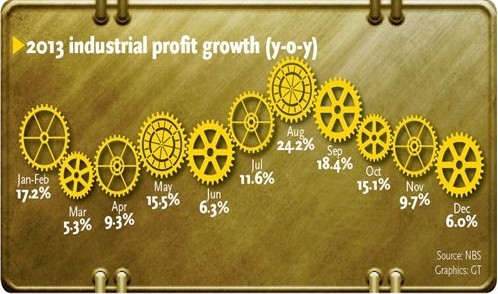

The profitability of China's major -industrial firms improved in 2013 despite a slowdown in the domestic economy, official data showed Tuesday.
The total profits of industrial companies with annual revenues of more than 20 million yuan ($3.3 million) reached 6.28 trillion yuan last year, up 12.2 percent from a year earlier, the National Bureau of Statistics (NBS) said in a statement.
The growth rate was higher than in 2012, when the companies' profits rose a mere 5.3 percent year-on-year.
The faster profit growth in 2013 was mainly because of growing sales, lower raw material costs, and a slight -decrease in operating charges, He Ping, an analyst with the NBS, said in the statement.
However, industrial firms saw profits from their main businesses rise by just 4 percent year-on-year in 2013, -according to the NBS.
"The gap indicates that non-core businesses contributed more to these industrial firms' profit growth," Li Heng, an analyst with Minsheng Securities, told the Global Times on Tuesday.
Li estimated that some big industrial firms might have gained from interest arbitrage, as they have been able to -obtain cheap loans from banks.
In December, profits earned by major industrial firms rose 6 percent from a year earlier, the slowest pace since April 2013, the NBS said.
The December industrial profit data and the fall in the flash HSBC Purchasing Managers' Index reading for January 2014 to 49.6 both point to softening economic growth momentum, analysts said.
Among the 41 industries surveyed by the NBS, 35 posted year-on-year profit growth last year, with the power, auto, computer and telecommunications sectors performing better. But there was a decline in profits for the coal, oil and gas sectors because of sluggish demand and falling product prices, -according to He.
Overseas-based businesses led the growth, with their combined profits up 15.5 percent year on year in 2013, followed by private firms with a 14.8 percent year-on-year profit growth, while State-owned enterprises (SOEs) saw a rise in profits of 6.4 percent.
"Private firms are more flexible than SOEs in terms of innovation and transformation, and many of them are moving from producing low-end and labor-intensive products to high value-added items," Luo Zhongwei, a research fellow at the Institute of Industrial Economics under the Chinese Academy of Social Sciences, told the Global Times on Tuesday.
"The macro-policy environment is also beneficial for private firms, thanks to a batch of market-oriented reforms announced after the Third Plenary Session of the 18th Communist Party of China Central Committee," Luo said.
Li from Minsheng Securities noted that many SOEs are in sectors burdened with overcapacity, which has hit their profit growth.
Although the State Council pledged in October 2013 to curb overcapacity in the steel, cement, and glass sectors, it is not an easy task because eliminating excess capacity will also have an impact on the country's fiscal revenues and the financial system, DBS Bank said in a research note published on January 22.
Nearly 67 percent of enterprises said it will take at least three years for them to eliminate surplus capacity, while another 22.7 percent said it would take more than five years, the Ministry of Industry and Information Technology said in a report last month, citing a survey of 3,545 enterprises conducted by the Development Research Center of the State Council.
The National Development and -Reform Commission has accelerated reforms of natural resource commodities pricing, which is likely to increase industrial firms' production costs in the short term and weigh on their profitability, the bank said.
Copyright ©1999-2018
Chinanews.com. All rights reserved.
Reproduction in whole or in part without permission is prohibited.